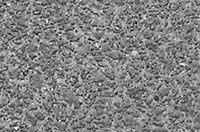Surface Texture
Surface textures are usually made during construction by dragging various materials or tools across the fresh concrete. This imparts a continuous series of undulations or grooves in the surface before the concrete hardens. The spacing, width and depth of the grooves affect surface friction, skid resistance and tire/road noise. The purpose of a surface texture is to reduce wet-weather accidents caused by skidding and hydroplaning.
Over the past 40 years there have been several shifts in the most commonly applied texture. For concrete streets and local roads, where vehicle speeds are not great enough to cause hydroplaning, burlap-drag or broom textures are typical. The most common texture on high-speed road and highway pavements in North America remains transverse tining. However, a shift is underway to longitudinal tining which has been shown to produce excellent long-term skid resistance and much lower tire/road noise qualities both in a vehicle and along the roadway.
Drag Textures |
|
Broomed Surface
Obtained using either a hand broom or mechanical broom device that lightly drags the stiff bristles across the surface. Produces 1.5-3 mm (1/16-1/8 in.) deep striations. Can be oriented either longitudinal or transverse to centerline of roadway. |
|
Turf Drag Surface
Poduced by trailing an inverted section of artificial turf from a device that allows control of the time and rate of texturing - usually a construction bridge that spans the pavement.. Produces 1.5-3 mm (1/16-1/8 in.) deep striations when using turf with 77,500 blades/m3 (xxxxx blades ft3). |
|
Burlap Drag Surface
Produced by trailing moistened coarse burlap from a device that allows control of the time and rate of texturing - usually a construction bridge that spans the pavement. Produces 1.5-3 mm (1/16-1/8 in.) deep striations. |
Tine Textures |
|
Transverse Tine
Achieved by a mechanical device equipped with a tining head (metal rake) that moves laterally across the width of the paving surface. (A hand tool is sufficient on smaller areas.) Optimal dimensions are: random tine spacing 10 to 40-mm (1/2 to 1-1/2 in.) with no more than 50% above 25 mm (1 in.), 3-6 mm (1/8-1/4 in.) tine depth, and 3 mm (1/8 in.) tine width. Skewing (as shown) has been found to reduce tire/road noise. |
|
Longitudinal Tine
Achieved in similar manner as transverse tining, except that tines are pulled in a line parallel to the pavement centerline. Optimal dimensions are: 20-mm (3/4-in.) uniform tine spacing, 3-6 mm (1/8-1/4 in.) tine depth, and 3 mm (1/8 in.) tine width. |
Exposed Aggregate |
 |
Exposed Aggregate
Mostly European practice of applying a set retarder to the new concrete surface, and then washing away surface mortar to expose durable chip-size aggregates. Requires uniformly applying chips to fresh surface and mechanically abrading surface to wash away still-wet mortar. |
Hardened Concrete Textures |
|
Diamond Ground
Longitudinal, corduroy-like surface made by equipment using diamond saw blades gang-mounted on a cutting head. The cutting head produces 164-197 grooves/meter (50-60 grooves/foot) and can remove 3-20 mm (1/8-3/4 in.) from the pavement surface. |
|
Diamond Groove
Grooves sawed into surface longitudinally for highways and transversely for airports. Made by same equipment for diamond grinding. Typically, the grooves are 6 mm (1/4 in.) deep, 3 mm (1/8 in.) wide and spaced 20 mm (3/4 in.) apart. On airports grooves are 6 mm (1/4 in.) deep, 6 mm (1/4 in.) wide and spaced 40 mm (1-1/2 in.) apart. |
|
Abrated (Shot Balasted)
Etched surface produced by equipment that hurls abrasive media within an enclosed housing. The abrasive media impacts the surface and removes a thin layer of mortar and aggregate. The depth of the removal is controllable and the dust is vacuumed into a baghouse. |
|


